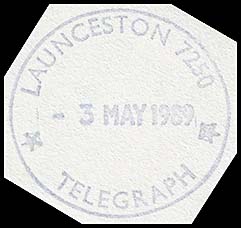Telegraph Offices on the first line.
- Australia 1901-1988
- New South Wales
- Queensland
- South Australia
- Tasmania
- Victoria
- Western Australia
- International
- Special aspects
Telegraph Offices included on the first line are:
| Bothwell | Brighton | Campbell Town | Evandale | George Town |
| Green Ponds | Launceston | Longford | Oatlands | Ross |
|
The telegraph wires were extended to Bothwell in January 1870 and temporary premises were used until a Telegraph Office was opened in 1871 at the Post Office with Sarah Robinson as the Operator. The Post Office had opened in 1832. Bothwell is the home of Ratho - the oldest golf course in Australia. It was built in the 1850s - before the telegraph was connected! It is also now the home for Nant distilleries. |
||
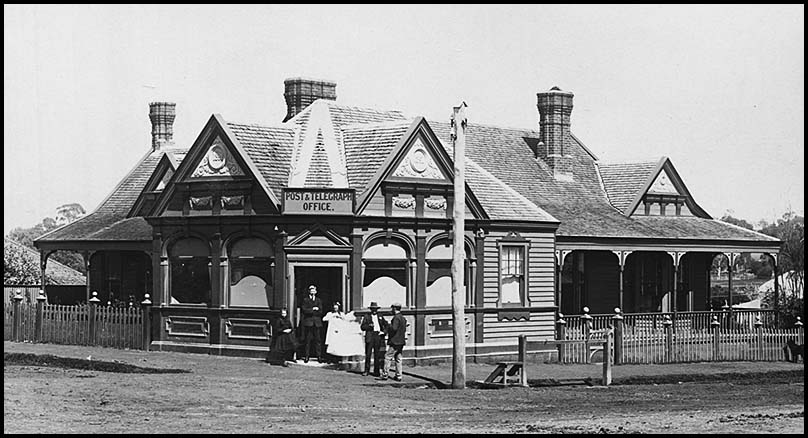 Bothwell Post & Telegraph Office - as confirmed by the sign above the door. This building was constructed about 1890. |
||
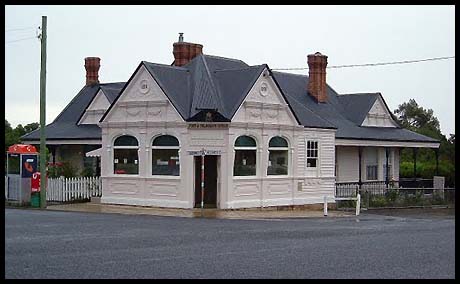 Bothwell Post Office - after recent renovations. |
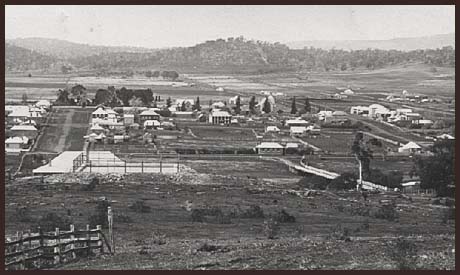 Bothwell and the surrounding region about 1910. |
|
Usage: The earliest recorded example of telegraph use at Bothwell is a transmission form (TC-TO-1B) dated 7 November 1870 used for a message from Bothwell to Hobarton - see elsewhere. |
The earliest recorded telegrams related to Bothwell are:
|
|
In the post-1902 period, postal cancellations used at Bothwell were of the standard format in steel. No special date stamp was issued to Bothwell for use with telegrams. |
||
The type 2C steel date stamp:
|
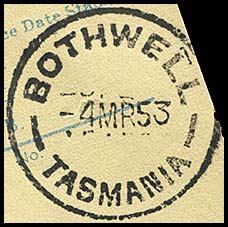 4 March 1953. Used on AW-DO-10 (1950). |
|
During a visit to New York in 1854, John Young wrote to his friend and neighbour at Bothwell as follows:
|
||
| Brighton (Pontville).
The Telegraph Office was located at the Post Office (by 1871). Brighton was, for a short time, discussed by Lachlan Macquarie as being the place for the capital of the penal colony. |
||
| The earliest indication of the operation of the Telegraph Office at Pontville is an ad hoc form using plain light blue paper for a telegram probably sent from Pontville (to Hobart?) on 11 July 1871. The cost of this message was 2/3 for the 25 words1 shilling for the first 10 words and 1d for each extra word (15d = 1s 3d). Following the '2/3' is the annotation FREE because the telegram about Electoral Rolls was Government business. |
||
|
||
Personnel. 1871: Robert Dyer was appointed as Operator |
||
Usage: The earliest recorded telegram to Brighton is 19 June 1871 from Green Ponds (Cable form). |
||
Unframed date stamp were used at Brighton for telegram work. The only examples known were all used on unofficial (or ad hoc) telegram forms - cut from ordinary writing pages or by tearing usual telegraph forms into two pieces.
|
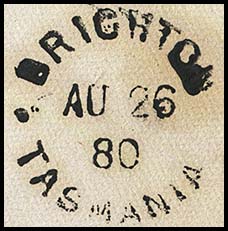 26 August 1880. |
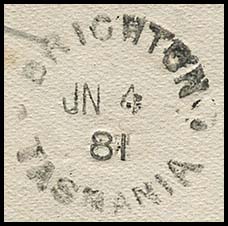 4 June 1881.
|
| A military base had first been established at Brighton in 1826. During the first and second World Wars, it was a base for preparing troops. In the latter part of the Second World War, Brighton Camp was also used to house prisoners of war and after the war it became a reception camp for refugees from Europe. From the early 1950s onwards, Brighton's primary use was for the training of members of the Citizens Military Forces. | 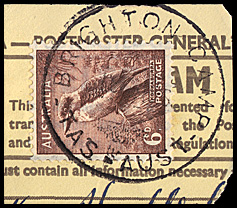 |
Brighton Camp. 1956. Used on a telegram piece from form AW-TO-9Bb (issued 1946). |
Personnel: February 1861: the Launceston Examiner reported that "a young lady is now joining through a course of instruction for the purpose of taking charge of the Telegraph office at Campbell Town. We hear that this young lady is likely to become one of the smartest operators on the line". That Operator was Miss Palliser. |
| The earliest indication of the operation of the Telegraph Office is a telegram delivery form received at Campbelltown from Hobart on 13 January 1903. |
| George Town.
In 1871, had offices at Low Head (2 staff) and Nine Mile Springs (operator A.T. Morrison). A telegraph office was opened to the public in 1873.
|
||
|
The telegraph wires were extended to Green Ponds in January 1870. The Telegraph Office may have been opened later in the year at a location separate from the Post Office. Green Ponds was used as a telegraph station for surrounding towns which did not have telegraph facilities at the time. An example of a message written on an envelope as a transmission form and sent from Bothwell to Green Ponds in 1875 for onward transmission is shown elsewhere. In September 1881, discussions were held to merge the Post and Telegraph Offices into a new office within the context of merging all the public offices (Municipal, Police, Library, lecture theatre, etc) into the same premises. The district had been settled about 1814 and was called Green Ponds. The town was renamed Kempton in 1838 although the Post Office did not change its name to Kempton until 18 March 1895. The municipality around Kempton is now called Green Ponds. The name Kempton originated from Captain Anthony Kemp who was the first to receive a land grant in the area - now known as Mount Vernon. |
||
There is a hand written summary on the reverse of a Cable transmission form showing 3 messages had been sent during the week ending 13 August 1870 and 4 messages in the following week. The earliest two recorded telegrams from Green Ponds are both transmission forms for:
|
||
|
||
| To enter the discussion about the use of names essentially at present referring to the same location, the following transmission form (TO-TO-2) was used for a message to be sent from Mount Vernon to Hobart on 24 June 1871. | ||
In addition, there are:
|
||
A transmission form was used at Green Ponds (date unknown - but maybe about 1880) to utilise a major development. The South Australia connection to Western Australia at Eucla had been made in December 1877. The message was sent from Green Ponds to Greenough in the Mid-West region of Western Australia - utilising the inter-colonial link. This is the earliest evidence of a message being transmitted over that link. |
||
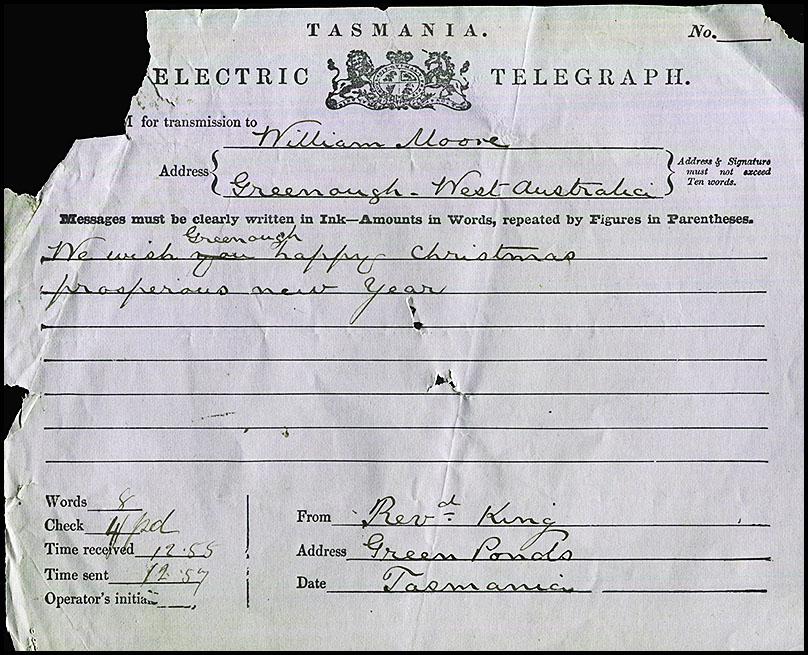 Transmission form TC-TO-3E used at Green Ponds - date unknown. |
||
No date stamp was issued to Green Ponds for use with telegraphs. Postal date stamps were used. |
Used on TC-DO-3A. |
|
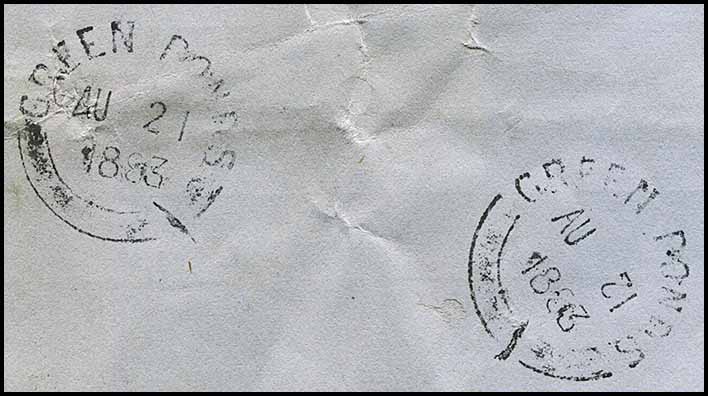 Two Green Ponds date stamps for 21 August 1883 on the reverse side of a TC-TO-3E transmission form. The day wheels for the right strike had been set in reverse but this was corrected for the left strike. Only recorded example. |
||
| Launceston.
Originally called Port Dalrymple. The first telegraph office in Launceston opened on 8 July 1857 to send a telegram to Hobart. The Office was in George Street opposite Patterson Street. In 1881, the office was moved "to more commodious quarters". |
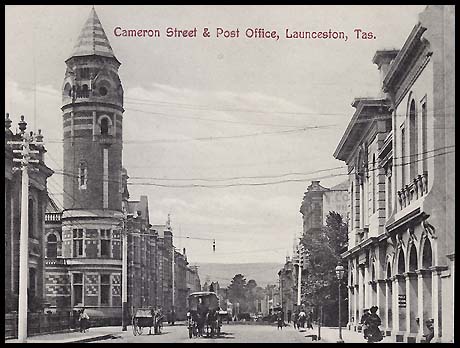 Launceston Post & Telegraph Office and Cameron Street. |
||
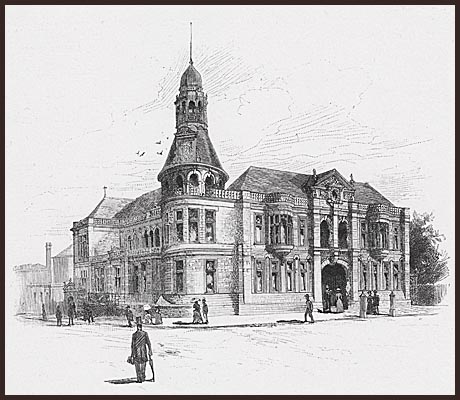 Engraving of the "new" Launceston Post Office. "Pictorial Atlas of Australia", 1882. |
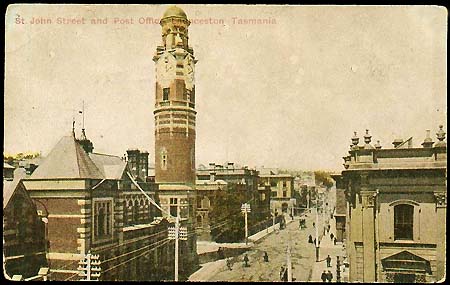 Launceston Post & Telegraph Office and St. John Street. |
||
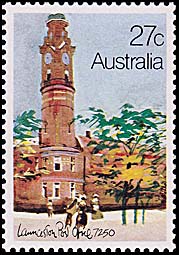 The Australia Post stamp depicting Launceston Post Office. Issued: 4 August 1982. |
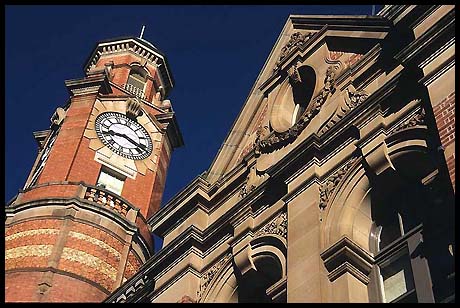 Modern photograph of the facade and tower. |
In the annual Report on the Post and Telegraph Department for 1883, the following statistics were included: Intra-Tasmanian business - 1883:
Inter-colonial business - 1883:
|
|
Personnel: July 1857: Mr. G. B. Butcher was appointed as the first Officer-in-Charge at Launceston. He was the brother of the then newly appointed Superintendent of Telegraphs Mr. W. H. Butcher. |
|
| Plain cover sent from Hobart to Mr. Allison of the Telegraph Office in Launceston on 18 April 1895. |  Provenance: Clemente (Spink Sale September 2016, Lot 269). |
Rubber oval date stamps - TELEGRAPH OFFICE/ LAUNCESTON. |
|||
|
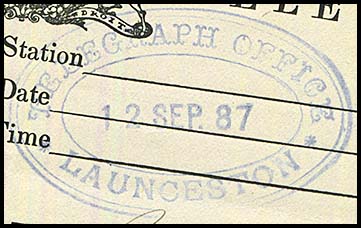 12 September 1887. Used on TC-DO-4A. Provenance: Clemente, Johnstone. |
||
|
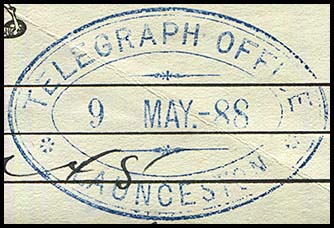 9 May 1888. Used on TC-DO-4A. Provenance: Clemente, Johnstone. |
 8 September 1889. Used on TC-DO-4B. |
|
|
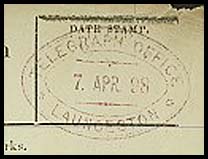 7 April 1898. Prestige Aug 2005 Lot 411. |
||
| Rubber rectangular handstamp. Launceston (RRH1-L). Has a consecutive counter number to the right of the date. Used on Telegrams.
|
For the important telegram on which this date stamp was used, see the Delivery form from the Governor's Private Secretary. |
|
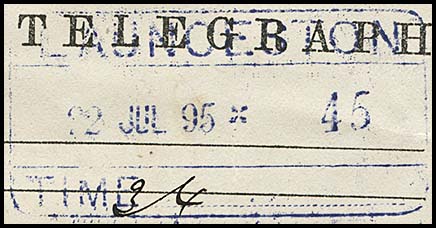 22 July 1895. Used in TC-DO-4A. |
Circular steel date stamps with Launceston/ Tasmania. |
Two line date. Two digit year. Dots for separation are towards the base of the letters. No code letter under Launceston. Diameter: 23 mm. |
|
Used on TI-MO-3. |
|
Two line date. Two digit year. Has circle stops for separation. No code letter under LAUNCESTON. Diameter: 24 mm. Used from 28 January 1899 (TC-DO-5A) to 10 March 1904. |
Used on TC-DO-5A. |
Used on TI-RO-2. |
|
Two line date. Two digit year. Has cross stops for separation. No code letter under LAUNCESTON. Diameter: 25 mm. |
|
||
Two line date. Two digit year. Has no stops for separation. No code letter under LAUNCESTON. Diameter: 23 mm. Clemente had reported that this date stamp had never been seen on a telegram form. |
Used on TC-DO-5A. |
Used on TI-DO-6. |
|
Circular rubber date stamps:
RC3 Launceston.
| No separation stars. Type 2a (1v) rubber date stamp.
|
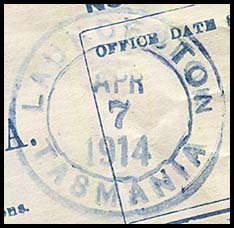 7 April 1914. 7 April 1914. Used on TI-DO-3B. |
|
| Has very small stars at the center of the letters separating the top and bottom words. Type 2a (1v) rubber date stamp.
|
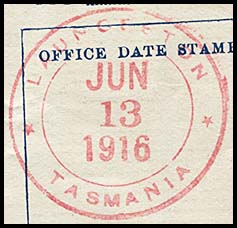 13 June 1916. Used in red. On TI-DO-3C. |
|
|
|
|
RC6 Launceston. Has large 5 pointed stars separating the top and bottom sections. Type 2a (1v) rubber date stamp.
|
|
| Telegraph Office/ Launceston.
A circular SC1-TO date stamp was issued to the Office inscribed at the top TELEGRAPH OFFICE. LAUNCESTON at base. Diameter: 29 mm. Rated: R. Number in the Census: 10+ Also used on AW-DO-10 (45). |
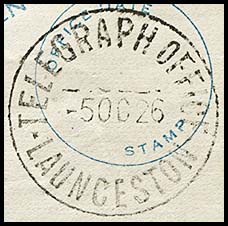 5 October 1926. Earliest recorded date. Used on AB-DO-3 (D). |
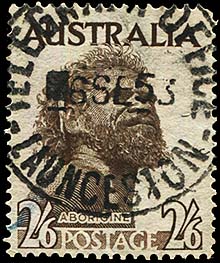 6 September 1953. On 2/6 One Pound Jimmy. |
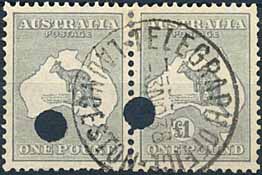 Telegraph Office, Launceston. 3 November 1938. Used on a punctured pair of grey £1 Kangaroo on Map. Mossgreen, March 2015 Lot 2074. |
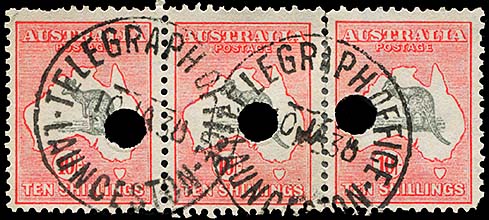 10 January 1938. C of A watermark. |
|
| Launceston/ Telegraph. Archival strikes of a rubber circular datestamp not recorded used on a telegram. Date of strike: 3 May 1989 which is beyond the date of availability of telegrams. Diameter: 31 mm. Rated: RRR. Number in the Census: 6. |
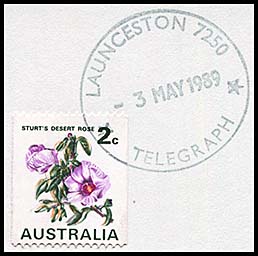 Launceston TELEGRAPH. Launceston TELEGRAPH.3 May 1989. |
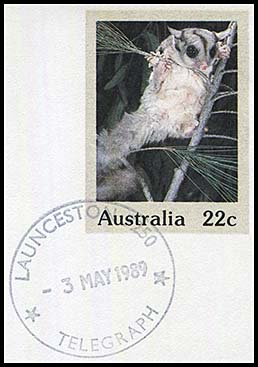 Launceston TELEGRAPH. 3 May 1989. |
|
||
| All four types of the Slogan date stamps used at Launceston . | 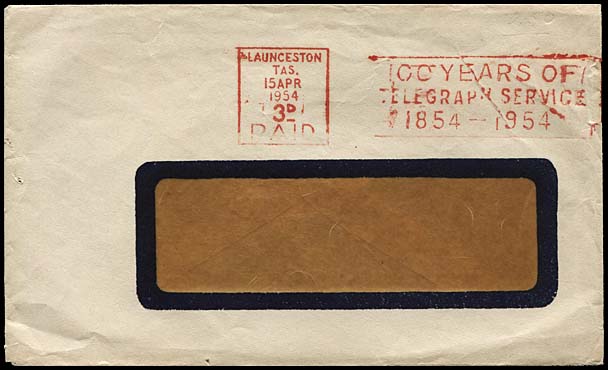 |
|
| Launceston Rail. | 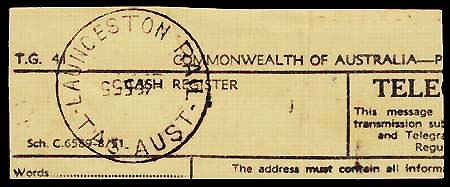 Source: Torsten Weller 2012. |
|
The Electric Telegraph office was opened separate from the Post Office. Personnel: The first Operator was W. Mason jnr. |
| The earliest indication of the operation of the Telegraph Office at Longford is a telegram transmission form sent to Longford from Green Ponds on 29 June 1971. |
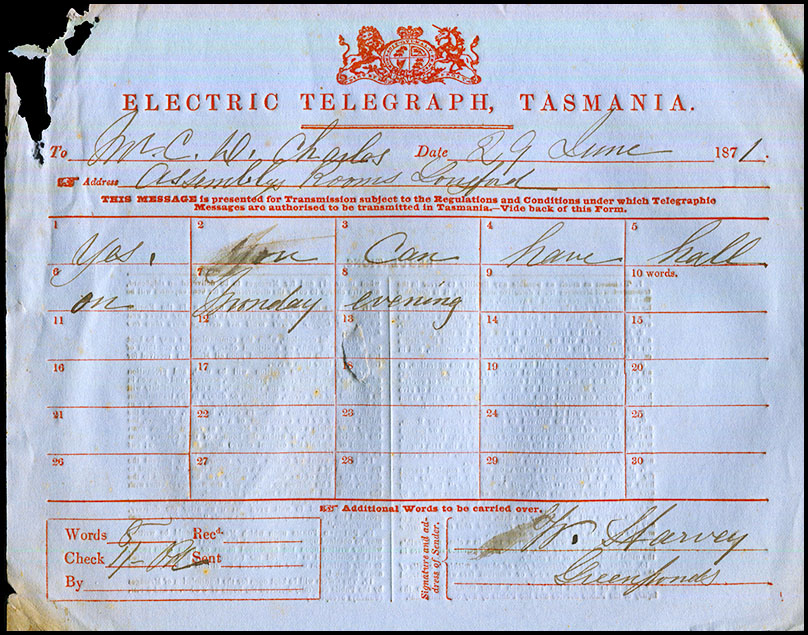 Transmission form TC-TO-2 used at Greenponds for a message to be transmitted to Longford on 29 June 1871. |
|
The Electric Telegraph Office was established in 1861 separately from the Post Office. The Post Office main route connected to Tunbridge, Anthill Ponds, Jericho, Spring Hill and Tunnack. |
|
Personnel: 1861: The first Operator at Oatlands was J. Ryan Jnr. |
|
Usage: The earliest indication of the operation of the Telegraph Office is a transmission form sent from Green Ponds to the Superintendent of Police at Oatlands on 17 January 1871. |
|
|
|
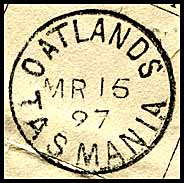 Oatlands. 15 March 1897. No separating marks between Used on TC-DO-5A. |
|
|
The Telegraph Office was established on 24 March 1865. It was separate from the (Money Order) Post Office. The Hobart Advertiser of 25 March 1865 reported "Mr Packer has been up to Ross for the purpose of putting all the apparatus in working order and Mr J. Thomas, an operator at the station in town, has now gone up for a few weeks to superintend until Miss Hall is perfectly au fait in her new duties. This is the second lady operator we shall have in Tasmania, Miss Pallisser being in charge at Campbell Town". Personnel: March 1865: Miss Hall, who was the Postmistress, was also appointed as Operator. Unfortunately the North West Post of 1 August 1905 announced that "Salary for the three months during the period of her suspension from duty is allowed to Miss Elizabeth Hall late Postmistress at Ross whose resignation from the Public Service was enforced". |
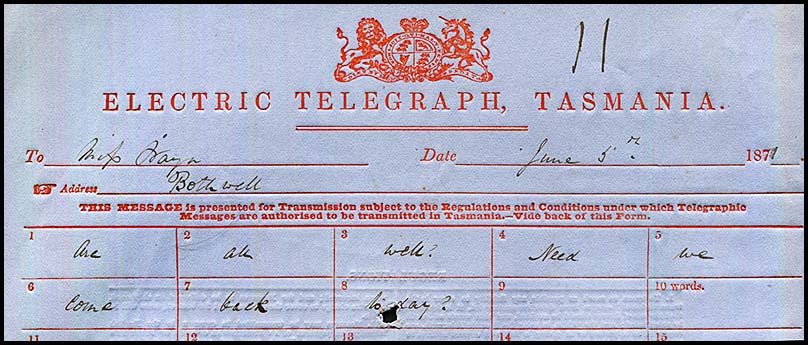
 1871 July 11.jpg)
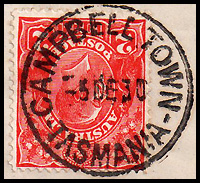
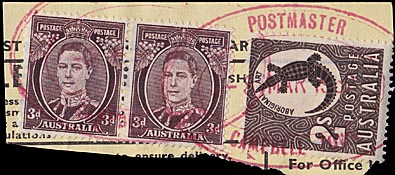
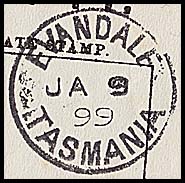
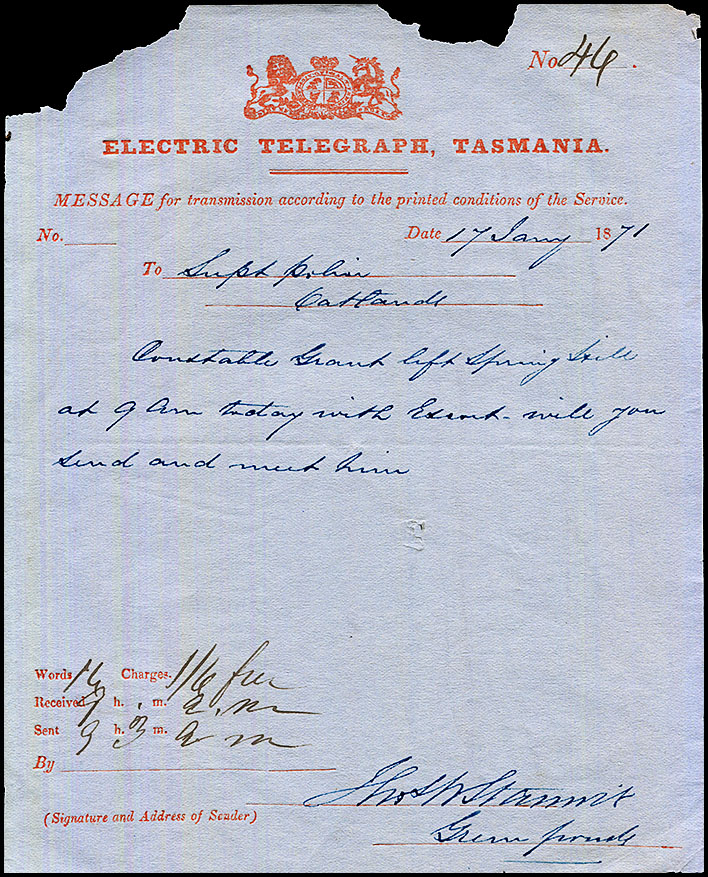
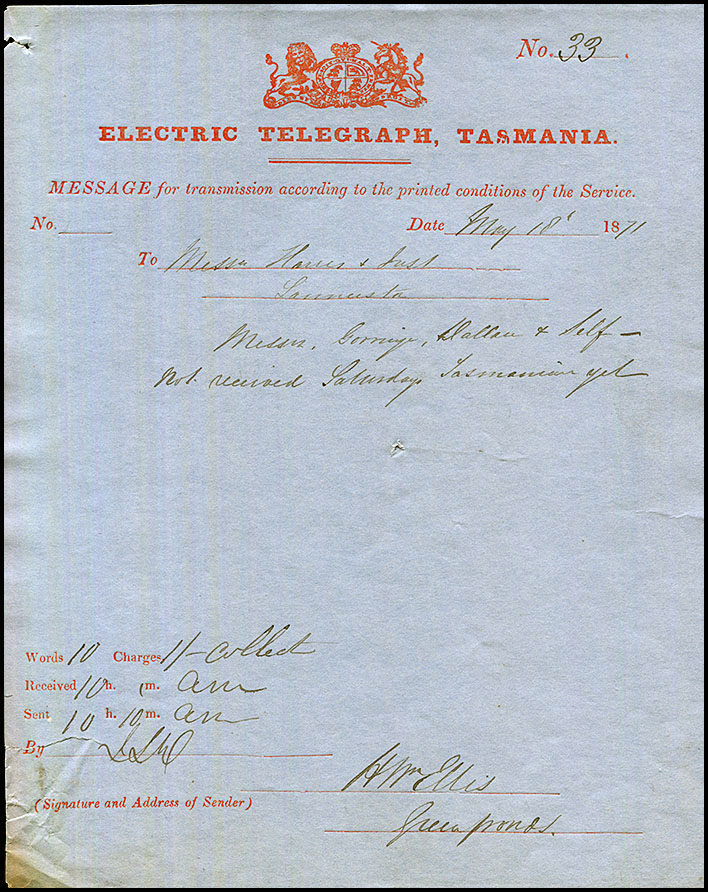
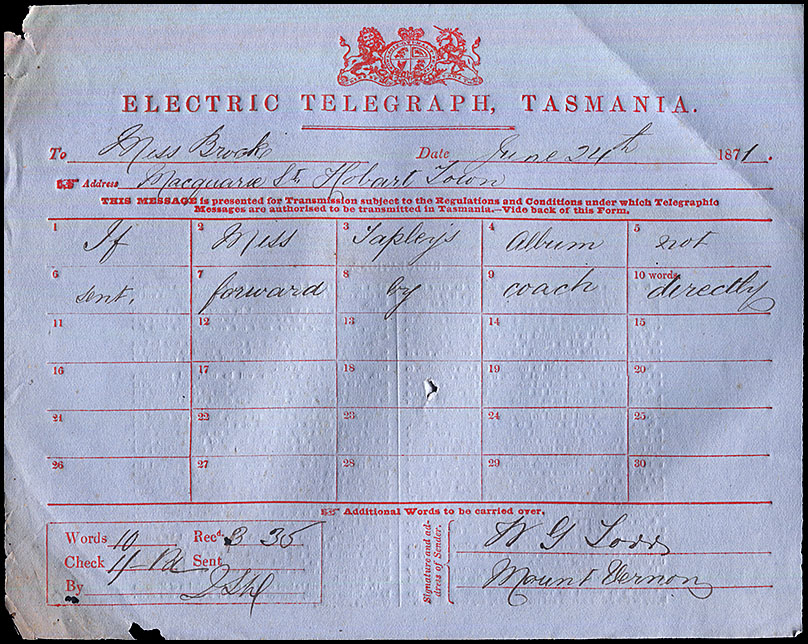
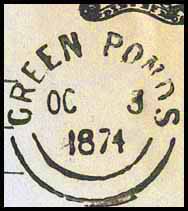

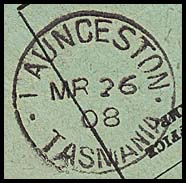
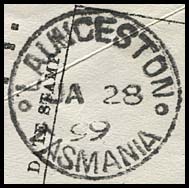
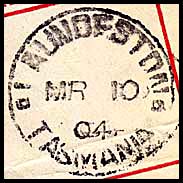
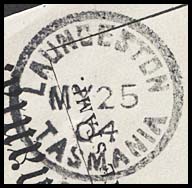
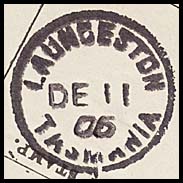
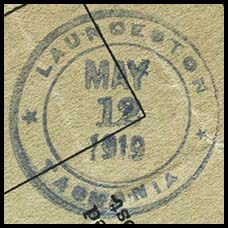
 Rubber blue.jpg)
